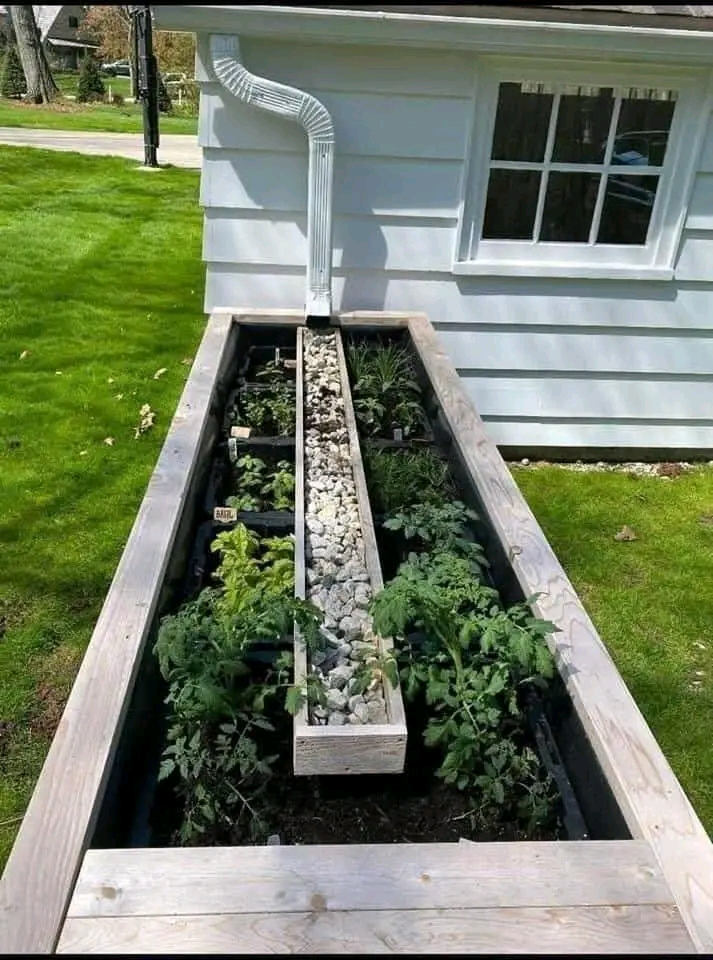Introduction and Origin
“I used to watch the rainwater pour from our gutter and pool around the yard, doing nothing but making mud puddles.” That single moment of reflection sparked a transformation—from wasted runoff to a thriving garden. What began as curiosity at the window evolved into a functional, eco-friendly raised garden bed that uses gravity, planning, and rain to grow life.
This project started with a question: What if that water could actually work for us? The answer is a self-watering, low-maintenance, and deeply satisfying garden system powered by nature itself.
Cultural Significance
In a world where sustainability and mindful living are becoming essential, this project echoes ancient agricultural wisdom—capturing rain, directing water efficiently, and letting the earth do its work. Many indigenous and traditional farming methods around the globe have long harnessed natural rainfall to grow food. Today, this DIY garden approach connects us to those timeless practices while empowering modern home gardeners to live greener and grow smarter.
Ingredients Quantity
Here’s what you’ll need to create your own Rain-Powered Raised Garden Bed:
- 1 raised garden bed frame (wood or recycled materials) – approx. 4’x8′
- 1 downspout positioned to direct rainwater into the bed
- 2–3 bags of gravel or river rock (for the central trough)
- High-quality soil and compost mix (enough to fill the bed)
- Perforated drainage pipe (optional, for even water flow)
- Landscape fabric (optional, for weed control)
- Starter plants or seeds (e.g., tomatoes, basil, peppers)
- Mulch (straw or bark, optional)
Optional Additions
- A rain diverter or barrel overflow system for heavy rain
- Drip irrigation backup for dry spells
- Trellises or plant cages for vertical support
- Organic fertilizer or worm castings for added nutrients
- Decorative stone edging or solar garden lights for aesthetics
Tips for Success
- Choose the right spot: Place the bed where it will catch direct downspout flow.
- Level the base: A flat foundation helps water distribute evenly.
- Use quality soil: Blend compost with topsoil for drainage and nutrients.
- Add gravel smartly: The trough down the middle allows natural absorption.
- Monitor your moisture: Use a soil moisture meter to check hydration levels.
- Rotate crops seasonally: Keep the soil healthy and reduce pests naturally.
Instructions
- Position the bed under your gutter’s downspout. Ensure the water will flow into the bed’s center.
- Lay landscape fabric at the base (optional).
- Pour gravel in a trough-like shape down the center (about 6″ wide and 3–4″ deep).
- Optionally, lay a perforated pipe in the gravel for even water distribution.
- Fill the rest of the bed with your soil-compost mix, creating a gentle slope away from the gravel trough.
- Plant your crops, focusing on veggies and herbs that enjoy consistent moisture.
- Add mulch to retain moisture and suppress weeds.
- Let the rain do the work! Monitor and enjoy as your plants flourish naturally.
Description
This garden is more than just a DIY project—it’s a living, growing testament to the power of observation and resourcefulness. With every rainfall, water nourishes your plants, cutting out hoses and effort while minimizing waste. The design is simple, yet the results are lush, green, and incredibly rewarding.
Nutritional Information
While not a typical “dish,” here’s what you’re cultivating in terms of value:
- Fresh produce: Tomatoes, herbs, and peppers packed with vitamins and antioxidants
- No chemicals: Home-grown means you control what goes into your food
- Hydration efficiency: Uses rainwater = zero added water costs
- Mental nourishment: Gardening reduces stress and promotes mindfulness
Conclusion and Recommendation
If you’ve ever looked out the window and wished for a more sustainable, fulfilling use of your space—this is it. A rain-powered raised garden bed is an empowering way to take control of your food, your water use, and your impact. It doesn’t require perfection—just intention, a little effort, and a willingness to try.
Embracing Healthful Indulgence
Gardening is a form of indulgence that feeds body, mind, and planet. It’s an invitation to slow down, to observe, and to live in tune with the natural world. By channeling rainwater into nourishment, you create something both delicious and deeply meaningful. And in doing so, you’ll find that healthful indulgence is less about doing more—and more about letting nature do what it does best.
Let me know if you’d like this formatted for a blog post, turned into a social media carousel, or paired with a planting calendar for different seasons! 🌿

